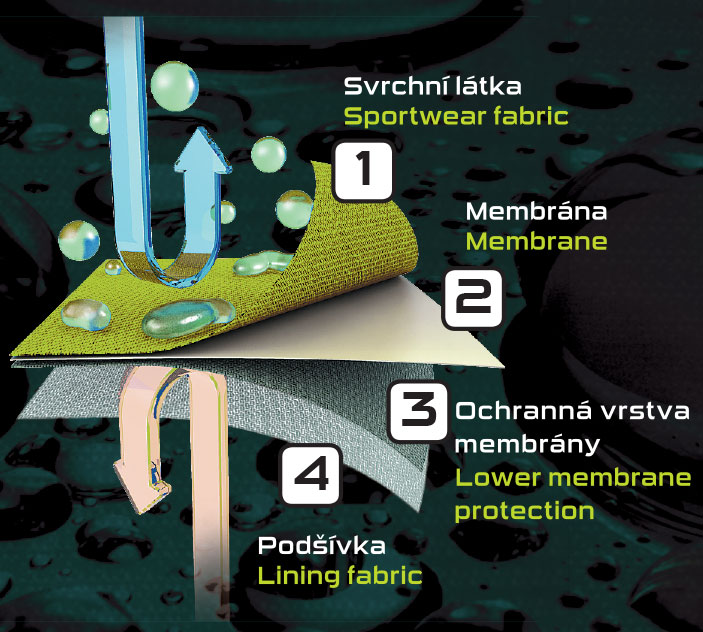Materials and technology
ACD Membrane - Clothing - Tents - Sleeping bags - Backpacks - Gelanots
It is a registered trademark of a unique membrane from a renowned Japanese manufacturer. Pinguin has more than 10 years of experience with its parameters, functionality and durability, which confirms the correctness of our decision to continue using this now traditional and proven product for Pinguin waterproof clothing under new commercial terms and under the new trademark A.C.D. (All Climate Dry) membrane.
A material that breathes. The A.C.D. membrane has no pores, which makes it fundamentally different from conventional microporous membranes. Nevertheless, the ability to let evaporated sweat through (breathe out) is second to none. This is due to the microstructure of the membrane made of a special polyurethane (PU) whose molecular structure and the mutual forces between PU and water molecules are optimal for this function. During physical exertion, a person heats up, sweats and the vapour concentration under his clothing increases. When a water vapour molecule gets close to the A.C.D. membrane, it is drawn between the PU molecules and becomes temporarily part of the membrane (i.e. the membrane is hydrophilic). Due to the higher temperature and water vapour concentration inside the garment, evaporated sweat is continuously forced through the membrane. This is as natural a phenomenon as water flowing from a higher place to a lower place.
Waterproof and windproof. The micropores of conventional membranes expand over time in stressed areas and let water through. Non-porous A.C.D. However, the membrane retains sufficient resistance to water pressure even after years of use. 100% wind resistance is essential to maintain the microclimate and thermal comfort of the user.
Durability and maintenance. A typical malady of conventional membranes is the gradual clogging of pores and thus deteriorating vapour permeability. Salts and fats contained in sweat, dirt and detergents can settle in the pores and clog them. A.C.D. Membrane does not suffer from this. It can be washed in the washing machine and with normal detergents, and can be gently tumble dried and ironed. It is not advisable to use only fabric softener, after washing it is recommended not to twist or wring the clothes, just let them drip.
It is a very lightweight membrane material made with a special technology where the membrane on the reverse side of the fabric is so resistant to mechanical damage that it does not need to be protected by a lining.
It is designed to produce lightweight and very packable garments that we can always have with us in case of bad weather.
It is a hydrophilic membrane that is laminated to the outer textile material of the sportswear. It forms a perfect protection against the weather and at the same time maintains a constant microclimate on the surface of the body at rest even during intense physical exertion.
It has been developed for active outdoor sports and its parameters satisfy even the most demanding comfort requirements of the user.
It is a so-called three-layer laminate, where the following three layers are joined by lamination: the upper fabric, the A.C.D. membrane and the lower membrane protection.
The material thus obtained is designed for garments for extreme conditions, it can withstand even higher water pressure, while the vapour permeability remains the same as in a two-layer membrane.











